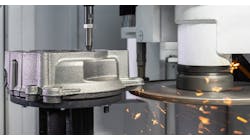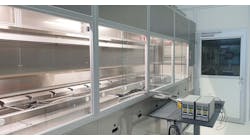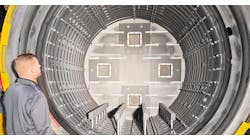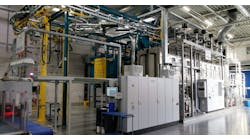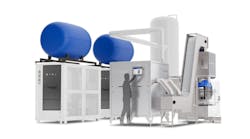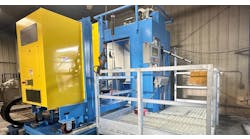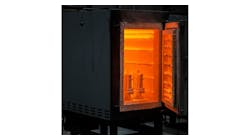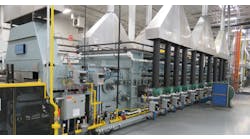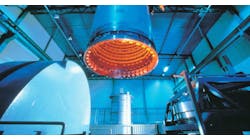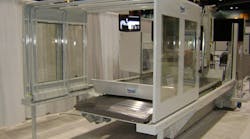When last we checked on Hoosier Pattern it had adopted additive manufacturing technology, making itself North America’s first commercial supplier of 3D-printed sand molds and cores. Now, it’s moving in another direction, or multiple directions if you will, installing a new bridge mill. The Decatur, IN, operation supplies foundry tooling as well as molds and cores, and performs CNC machining as further service to the wider manufacturing market.
Since its installation in May, the Milltronics BR-60 bridge mill allows Hoosier Pattern to machine extra large parts, including fabricated parts, plates, dies, aluminum molds, or patterns.
Milltronics’ BR-60 has a table size of 96X60 in., with standard travels of 100X60X28 (X-Y-Z).
“The machine is helping open doors for large-footprint tooling for the foundries’ needs in the way of coreboxes, patterns, and fixtures,” the shop’s Steve Murray reported.
While the company has offered CNC machining since its start-up in the late 1990s, the new bridge mill represents new capabilities in terms of the sizes of the tooling it can machine, without having to shift the parts on the worktable. “We have always done large work to meet the foundries needs, but now we can be so much more efficient,” Murray said.
He explained that Hoosier Pattern customers had lobbied for larger and larger foundry tooling, and the ability to produce that tooling at a competitive price prompted the shop’s interest in the new mill. “We were missing some potential sales because of the capacity, and the price inefficiency,” he said.
Selecting the new machine was the next step, but Murray explained that nearly all of the CNC machines operating at the shop are from the same manufacturer, Milltronics, Waconia, MN. In addition to the new bridge mill, other production options include 19 vertical machines, two horizontal CNC machines, two CNC lathes, one Blanchard grinder, one laser scanner, and two sinker EDM machines. As noted, its sand molds and cores are produced on an ExOne S-Max 3D printer machines.
“Having the same controls as most of the machines in the shop makes for a quick start-up, on the floor and in the CAD room,” according to Murray.
Because of the size and impact of the new bridge mill on the shop’s infrastructure, a new concrete pad had to be poured as a foundation. On the other hand, the Hoosier Pattern work force was generally well prepared to start operating it, as it functions with much the same programming and control platform as the existing machine tools there. “Every one of our designers and programmers fell right into place with this new machine,” Murray recalled. “It has been a very seamless integration of the machine into our work flow through the shop.
Those customers seeking the larger tooling capability have been pleased by the new capability. “For the type of foundry tooling we currently produce for our foundry customers, this machine is a good fit,” according to Murray.
He said the dimensional capabilities of the new machine add production capacity for the shop, and our customers. “Some of our 3D sand-printed cores are larger in size, and now we are able to offer them patterns on molding plates to match … to help keep the cost down for their foundry tooling needs,” he explained. “This machine helps marry the 3D-printed sand molds and cores that we produce and the traditional subtractive foundry tooling. The machine gives us a lot more freedom for our foundry customers.”
It’s not the largest bridge mill available, but it’s effective for Hoosier Patterns’ current customers, “and as our customers’ needs change we add capacity to meet those future needs,” he said.
There may be a longer strategy at work with the expansion of machining capability at Hoosier Pattern. “We want to go after larger work that compliments the new bridge mill, and also work from the mill that supports the 3D-printed sand capability we have,” Steve Murray told us. “We know our comfort level and will stay within that. We cannot be all things to all foundries. This size of machine will give us flexibility to offer our current customers more capabilities and offer our potential customers new possibilities with the traditional and additive technologies.
